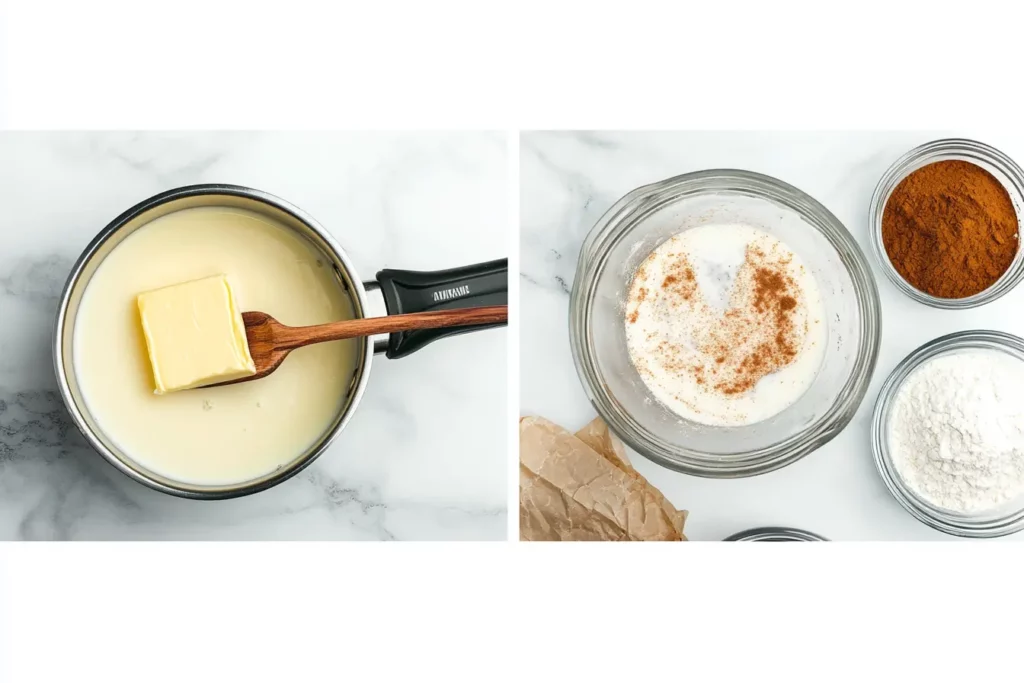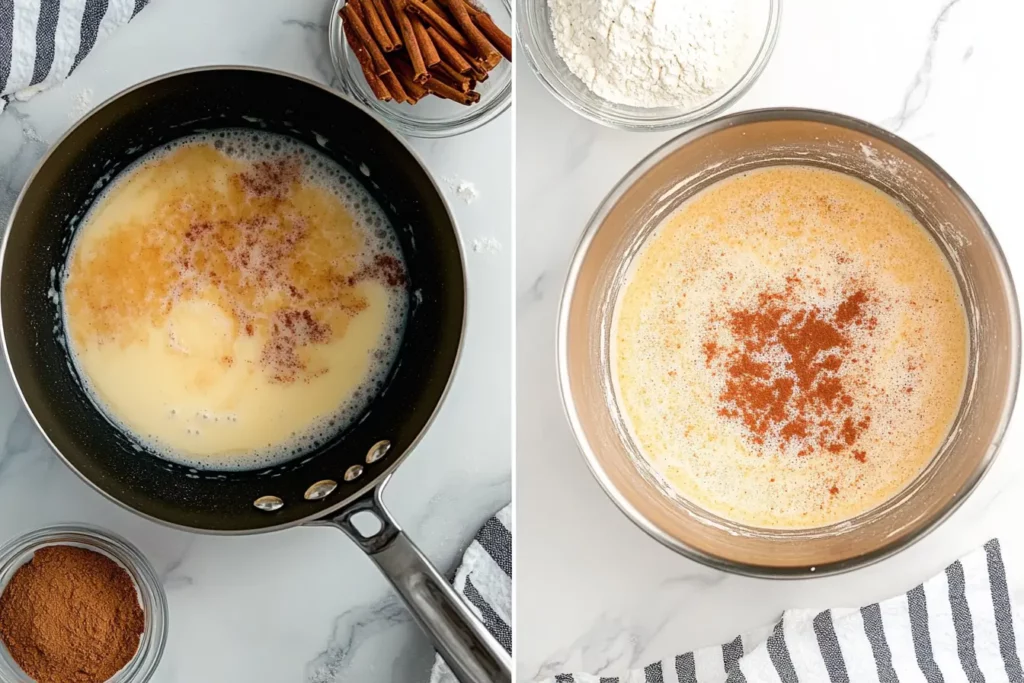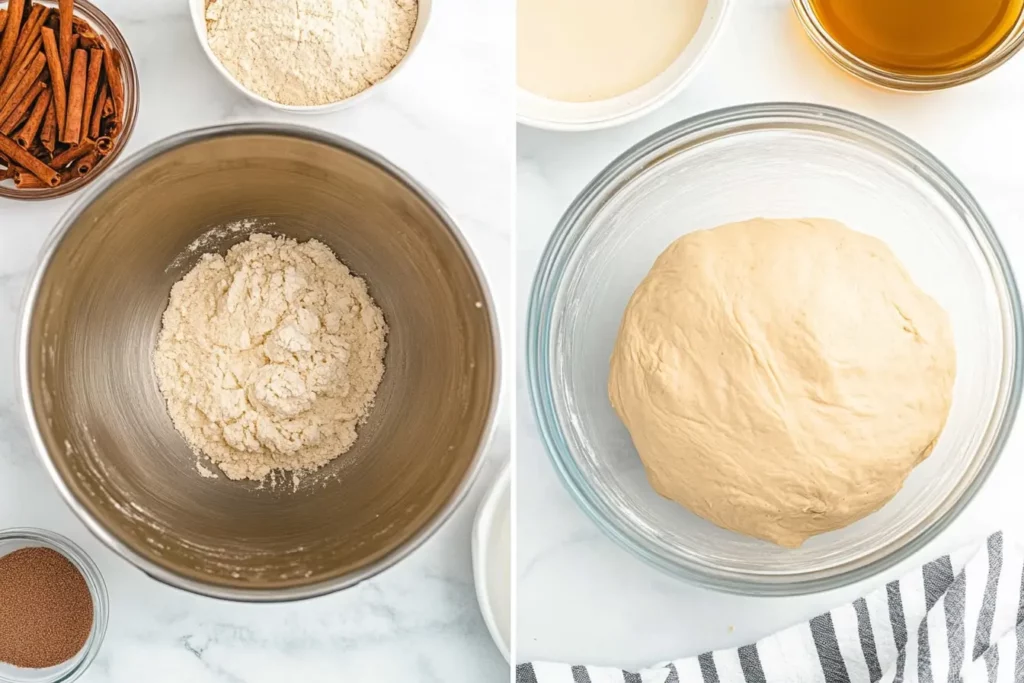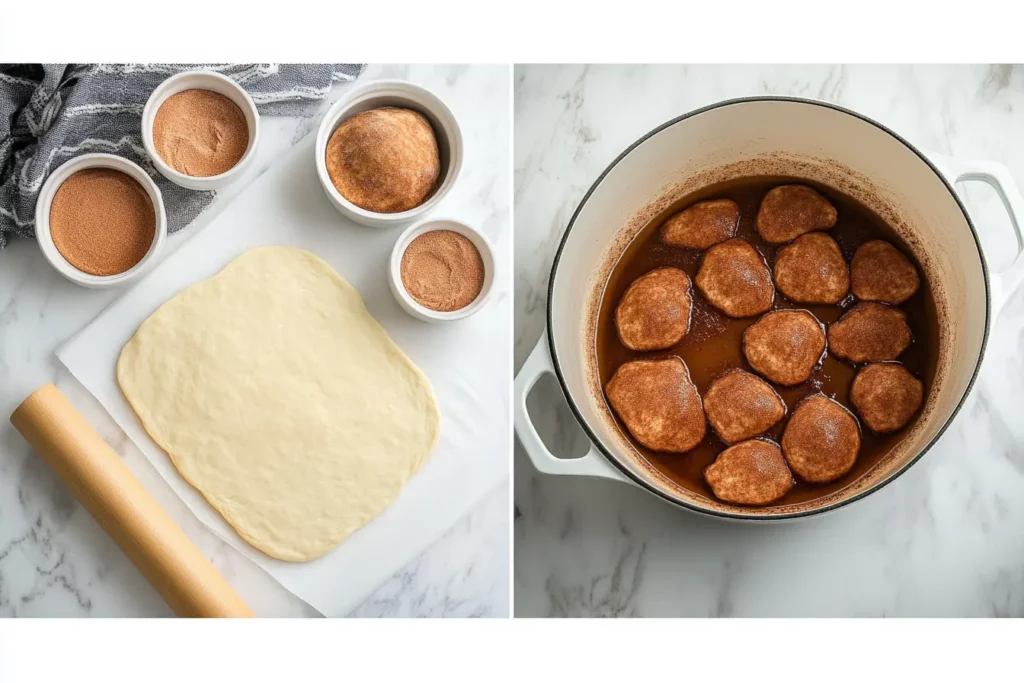🖋️ Written by Emma
Elephant Ears Recipe is your ticket to recreating that nostalgic fairground magic right in your kitchen. Known for its golden, crispy texture and sweet cinnamon-sugar coating, this beloved treat is a classic at state fairs, carnivals, and festivals across North America. Whether you remember grabbing one after a roller coaster ride or are just now discovering it for the first time, making elephant ears at home is surprisingly easy—and incredibly satisfying.
Elephant Ears Recipe isn’t just about fried dough—it’s about bringing comfort and joy to your table with simple ingredients and a quick cooking method. In this guide, we’ll walk you through everything from the history of this iconic treat to step-by-step instructions, topping variations, and even the difference between elephant ears and similar desserts like funnel cake and Canadian beavertails. Stick around and learn how to make this crispy, sugary masterpiece from scratch.
What Are Elephant Ears?
The Sweet Origins of Elephant Ears Recipe
Elephant Ears Recipe dates back to generations of fairground favorites that combine simple ingredients with a whole lot of flavor. This fried dough dessert gets its name from its large, flat, ear-like shape—crispy on the outside, soft on the inside, and dusted with cinnamon sugar or other sweet toppings. These treats are deeply rooted in American and Canadian carnival culture, but their origins stretch even further back to European fried pastries, especially German and Dutch variations.
While many know them as a county fair treat, elephant ears have also been passed down as family recipes. Whether you’re using a deep fryer or a skillet, the goal is always the same: a perfectly golden, slightly chewy piece of dough that’s generously coated in sugar. Elephant Ears Recipe has stood the test of time, mainly because it’s easy to make and universally loved.
Elephant Ears vs. Beavertails: What’s the Difference?
One common question that pops up with the elephant ears recipe is whether it’s the same thing as a beavertail. The short answer? They’re similar—but not identical. While both are types of fried dough desserts, beavertails (popular in Canada) often include more elaborate toppings, such as chocolate, bananas, and even savory ingredients.
In contrast, the traditional elephant ears recipe sticks with a minimalistic approach—focusing on cinnamon sugar or powdered sugar as the main topping. The dough used for beavertails is sometimes slightly richer and may include more butter or eggs, giving it a different texture. Elephant ears, on the other hand, are more straightforward but just as delicious.
So next time you’re craving a crunchy, sweet treat, remember this: if it’s big, flat, and cinnamon-sugary—it’s probably an elephant ear. But if it’s topped like a pizza and hails from Ottawa, you might be holding a beavertail.

Ingredients Needed for Homemade Elephant Ears
Essential Ingredients for the Best Elephant Ears Recipe
To make a perfect elephant ears recipe, you don’t need anything fancy—just a handful of pantry staples that come together to create magic. This simple fried dough treat relies on basic ingredients to give it that irresistible crispy yet chewy bite. Below are the essentials you’ll need:
| Ingredient | Purpose |
|---|---|
| All-purpose flour | Forms the base of your dough |
| Warm water/milk | Activates the yeast and helps form dough |
| Active dry yeast | Gives the dough a light, airy texture |
| Sugar | Adds sweetness to the dough |
| Salt | Balances the sweetness |
| Butter or oil | Adds richness and moisture |
| Vegetable oil | Used for deep frying |
| Cinnamon sugar | Classic topping for that sweet finish |
The dough is typically mixed, kneaded, and left to rise, giving it a soft and elastic texture that’s easy to shape and fry. Some versions of the elephant ears recipe may call for milk instead of water or include eggs for a richer flavor, but the basic version is incredibly easy and foolproof.
Flavor Variations and Toppings for Your Elephant Ears Recipe
One of the best things about making your own elephant ears recipe at home is getting creative with toppings. While cinnamon sugar is the go-to classic, there are so many fun ways to jazz things up. Here are some tasty options:
- Powdered sugar – Light and sweet, a popular carnival favorite.
- Chocolate drizzle – Melted chocolate or Nutella takes it over the top.
- Fruit compote or jam – Adds a tangy-sweet twist to balance the crisp dough.
- Maple syrup or honey – Perfect for those who love sticky-sweet desserts.
- Savory toppings – Yes, some people turn this into a savory snack with cheese, garlic butter, or herbs.
You can also use whole wheat flour or even a gluten-free blend if you want a healthier or dietary-friendly version of the elephant ears recipe.
How to Make Elephant Ears Recipe Step-by-Step
Preparing the Dough for Your Elephant Ears Recipe

The heart of any good elephant ears recipe is the dough. It needs to be soft, elastic, and easy to stretch without tearing. Start by activating your yeast in warm water or milk with a bit of sugar. Let it sit for about 5–10 minutes until it becomes foamy—that’s how you know the yeast is alive and ready to rise.
Once your yeast is ready, combine it with the flour, salt, sugar, and melted butter. Mix until a sticky dough forms. You can use a stand mixer with a dough hook or knead by hand on a floured surface for about 5–7 minutes. The dough should be smooth and elastic.
Place the dough in a greased bowl, cover it with a clean towel, and let it rise in a warm place for 1 hour or until it doubles in size. This is when the magic happens—the dough becomes light and fluffy, ready to fry into golden, crispy perfection.

Frying to Perfection: The Secret to Crispy Elephant Ears Recipe

Once your dough has risen, divide it into small balls—about the size of a lime. Roll each one out on a lightly floured surface until it’s very thin, about 1/8-inch thick. The thinner the dough, the crispier your elephant ears recipe will be.
Heat your oil in a deep skillet or frying pan to 375°F (190°C). Carefully slide one piece of dough into the hot oil. It should puff up instantly and start to brown within seconds. Fry for 30–60 seconds per side or until golden brown and crisp. Use tongs to flip and remove each piece, placing it on a paper towel to drain excess oil.
While they’re still hot, sprinkle with cinnamon sugar, powdered sugar, or your favorite toppings. Serve immediately while they’re fresh and warm. Trust us—elephant ears recipe straight from the fryer is next-level delicious.

Baking vs. Frying Elephant Ears Recipe – What’s Better?
Why Most People Fry the Traditional Elephant Ears Recipe
When it comes to the classic elephant ears recipe, frying is the traditional—and let’s be honest, the tastiest—method. Frying creates that signature golden, crispy texture that you can’t quite replicate in the oven. As soon as the thin dough hits the hot oil, it puffs up beautifully, forming a light interior with a crackly surface perfect for holding cinnamon sugar.
Another reason frying wins for many home cooks? Speed. From the moment your dough is shaped to the second it hits your plate, it’s only a few minutes. That fast cooking time also helps lock in the softness inside while giving the outside a satisfying crunch.
That said, not everyone loves the idea of deep frying at home. It can be messy, and there’s always that lingering scent of oil. That’s where baking comes in.
Healthier Baked Elephant Ears Recipe Alternative
If you’re looking for a lighter version of the elephant ears recipe, baking is a solid alternative. While you won’t get quite the same level of puff and crunch, baked elephant ears can still deliver on flavor—especially if you brush them with melted butter before popping them in the oven.
To bake, preheat your oven to 400°F (205°C). Place the rolled-out dough on a parchment-lined baking sheet, brush it with butter, and bake for 8–10 minutes or until lightly golden. As soon as they come out, sprinkle generously with cinnamon sugar.
While baking might not offer the same carnival-style experience, it’s a great option for families or those cutting back on fried foods. Plus, it’s cleaner, safer, and more convenient—no oil splatters or deep fryer cleanup needed.
Whether you bake or fry, the elephant ears recipe can be tailored to your preferences. It’s the toppings, the dough, and the love you put into making them that matter most.
Tips for Making Perfect Elephant Ears Recipe at Home
Common Mistakes to Avoid When Making Elephant Ears Recipe

Even though the elephant ears recipe is simple at heart, a few missteps can affect the final result. Let’s walk through the most common mistakes and how to dodge them:
- Dough too thick: Thick dough won’t puff up properly and can turn out chewy or undercooked. Always roll the dough super thin—about 1/8 inch—for that classic crispy texture.
- Oil not hot enough: If your oil isn’t at the right temperature (375°F or 190°C), the dough will absorb too much oil and become greasy. Use a thermometer or drop a small piece of dough in to test—it should sizzle and float instantly.
- Overcrowding the pan: Fry one or two at a time. Too many pieces can lower the oil temperature quickly, causing uneven cooking.
- Skipping the rest time: The dough needs at least 60 minutes to rise. Don’t rush it—this step gives you the light, airy base that makes the elephant ears recipe so good.
- Not draining properly: Let your fried dough rest on paper towels to drain excess oil before adding toppings.
Avoiding these mistakes makes the difference between a fair-quality snack and a soggy disappointment.
How to Store and Reheat Leftover Elephant Ears Recipe
Leftovers from your elephant ears recipe? It happens—and yes, they can still taste amazing the next day if you handle them right.
Storage Tips:
- Store cooled elephant ears in an airtight container at room temperature for up to 2 days.
- To prevent sogginess, don’t stack them until they’ve completely cooled.
Reheating Tips:
- Oven method: Preheat your oven to 350°F (175°C), then warm the elephant ears on a baking sheet for 5–7 minutes. This restores some of the crispiness.
- Air fryer: Perfect for quick crisping—just heat at 350°F for 3–5 minutes.
- Avoid microwaving: It makes them rubbery and limp, killing the texture.
For best results, try to enjoy your elephant ears recipe fresh. But if you do have leftovers, a little reheating magic brings them right back to life.
International and Cultural Twists on Elephant Ears Recipe

What Canadians Call Elephant Ears Recipe
If you’ve ever wandered through a Canadian fairground, you may have seen a familiar treat under a different name—BeaverTails. While the base concept is nearly identical, Canadians refer to their version of the elephant ears recipe as “BeaverTails,” inspired by the shape of the national animal’s tail.
Unlike the traditional elephant ears recipe, which usually features simple cinnamon sugar, Canadian BeaverTails go big on toppings. Think Nutella with bananas, maple butter, crushed Oreos, and even savory toppings like garlic and cheese. The dough used in some BeaverTail recipes may be a little richer, with added butter or eggs for extra softness.
Despite the regional name change, the heart of the recipe remains the same: thin, fried dough that’s warm, sweet, and utterly irresistible.
Elephant Ears Recipe Around the World: Similar Treats Globally
The elephant ears recipe may be an American carnival classic, but versions of this crispy delight exist across the globe. Many cultures have their own take on fried dough, and the similarities are striking. Here are a few international favorites that resemble elephant ears:
| Country | Name | Description |
|---|---|---|
| India | Malpua | A sweet pancake-style fried dough with syrup |
| Mexico | Buñuelos | Crispy thin fritters dusted in sugar and cinnamon |
| France | Oreillettes | Thin, deep-fried pastries eaten during holidays |
| Italy | Frittelle or Zeppole | Fried dough balls often served with sugar |
| Hungary | Lángos | Savory fried dough topped with cheese or garlic |
Though these versions may differ in shape, toppings, or sweetness, the concept is universal—fried dough is beloved everywhere. The elephant ears recipe is just one regional twist on a global favorite.
Trying different styles can bring cultural flair into your kitchen. Whether you stick to the classic or go international, you’re guaranteed a delicious result.
Exploring Elephant Ear Vegetables and How They Relate to Elephant Ears Recipe
Are Elephant Ear Plants Edible Like the Elephant Ears Recipe?
Although they share a name, the elephant ears recipe and the elephant ear plant are two entirely different things. One is a beloved deep-fried dessert, while the other is a large leafy plant found in tropical regions and home gardens. But here’s where it gets interesting—certain varieties of elephant ear plants are edible, specifically taro and colocasia species.
However, raw elephant ear plants contain calcium oxalate crystals, which can cause irritation if not prepared properly. These plants must be thoroughly cooked—usually boiled or steamed—to make them safe for consumption. So, while they may never replace your favorite elephant ears recipe at the fair, they do have culinary value in some cultures.
In Caribbean, Southeast Asian, and African cuisines, elephant ear leaves and roots (like taro) are used in stews, soups, and even as wraps for meat and rice.
How to Prepare Elephant Ear Vegetables Safely at Home
If you’re curious about trying edible elephant ear plants at home, proceed with caution and follow proper prep steps:
- Identify the variety: Only specific types like Colocasia esculenta (taro) are edible.
- Wear gloves when handling raw leaves: The calcium oxalate can irritate your skin.
- Boil thoroughly: Most toxins are neutralized with high heat. Boil leaves and stems for 30–45 minutes until soft.
- Use them in recipes: Try them in curries, soups, or as a wrap for steaming rice and fish.
While this has little to do with the sweet, fried elephant ears recipe that’s served at fairs, it’s a fascinating culinary coincidence. One “elephant ear” makes a great dessert, the other—a wholesome vegetable dish. Just don’t confuse the two when you’re meal planning!
Elephant Ears Recipe vs. Funnel Cake – Which One Wins?
What’s the Difference Between Funnel Cake and Elephant Ears Recipe?
While they often appear side by side at fairs and festivals, the elephant ears recipe and funnel cake aren’t quite the same treat. Both are fried dough desserts, sure, but they differ in texture, preparation, and even taste.
Funnel cake is made from a pourable batter, which is streamed through a funnel into hot oil, forming a lacy, tangled, crispy nest of fried goodness. In contrast, the elephant ears recipe uses a yeast-based dough, which is rolled flat by hand before frying. This gives elephant ears a larger, smoother, and chewier texture compared to the airy crunch of funnel cakes.
Here’s a quick side-by-side comparison:
| Feature | Elephant Ears Recipe | Funnel Cake |
|---|---|---|
| Dough Type | Yeast dough, rolled flat | Pourable batter |
| Texture | Crispy edges, soft center | Light, crunchy, airy |
| Shape | Large, flat, round (like an ear) | Lacy, web-like nest |
| Toppings | Cinnamon sugar, powdered sugar | Powdered sugar, fruit, chocolate |
| Prep Style | Rolled and fried | Poured and fried |
So, while they both hit the sweet spot, the elephant ears recipe delivers more of a chewy, warm pastry experience, while funnel cake feels more like a crispy carnival web.
Which One Is Easier to Make at Home?
If you’re looking to recreate a fair food classic in your kitchen, the elephant ears recipe might just edge out funnel cake when it comes to ease—especially if you don’t have a funnel or deep fryer. With elephant ears, you can mix the dough, let it rise, roll it out, and fry it in a skillet. No need to worry about batter consistency or making intricate shapes.
That said, funnel cake is still a great option if you want something fast and don’t want to wait for dough to rise. It really comes down to personal taste and kitchen tools.
But if we’re choosing based on nostalgic flavor, easy prep, and satisfying texture—the elephant ears recipe takes the crown.
Serving Ideas and Dessert Pairings for Your Elephant Ears Recipe

Top Toppings to Elevate Your Elephant Ears Recipe
Once you’ve mastered the base, it’s time to take your elephant ears recipe to the next level with flavorful toppings and creative combinations. While the classic cinnamon sugar is always a win, the possibilities go far beyond tradition.
Here are some topping ideas to try:
| Topping Type | Ideas |
|---|---|
| Sweet Classics | Cinnamon sugar, powdered sugar, honey |
| Chocolate-Based | Nutella, chocolate drizzle, hot fudge |
| Fruity & Fresh | Strawberry slices, apple compote, lemon zest |
| Crunch & Texture | Crushed nuts, granola, toffee bits |
| Decadent & Fun | Marshmallow fluff, whipped cream, caramel |
Want a fall-inspired twist? Try apple pie filling with a drizzle of caramel. For a s’mores version, add chocolate chips, graham cracker crumbs, and toasted marshmallow cream. There’s no limit to how you can personalize your elephant ears recipe.
Perfect Drinks and Dessert Pairings with Elephant Ears Recipe
The rich, fried nature of elephant ears makes them perfect for pairing with refreshing or complementary desserts and drinks. Whether you’re hosting guests or treating yourself, these combos enhance the flavor and experience:
Drink Pairings:
- Iced coffee or cold brew – balances the sweetness
- Chai latte – cinnamon and spice flavors match beautifully
- Sparkling lemonade – brightens the palate
- Vanilla milkshake – double the indulgence!
Dessert Pairings:
- Mini cheesecake bites – creamy contrast to the crispy dough
- Fruit sorbet – light and fruity counterbalance
- Fresh berries with cream – keeps it seasonal and simple
If you’re serving elephant ears recipe at a party or event, consider setting up a DIY topping bar so guests can customize their treats.
Frequently Asked Questions About Elephant Ears Recipe
How do you cook elephant ears?
To cook an elephant ears recipe at home, start by preparing a yeast-based dough, letting it rise, and then rolling it out thin. The dough is then deep-fried in hot oil at 375°F (190°C) for about 30–60 seconds per side until golden brown. After frying, they’re traditionally topped with cinnamon sugar, powdered sugar, or your favorite sweet toppings.
How to prepare elephant ears?
Preparing the dough is key to a great elephant ears recipe. Mix all-purpose flour, yeast, warm water or milk, a bit of sugar, and salt. Let the dough rise, then divide it into small balls. Roll them out very thin and fry until crispy and golden. Serve warm with your preferred toppings. For baked versions, use the same dough but cook in the oven at 400°F for 8–10 minutes.
Are elephant ears and beavertails the same thing?
They’re very similar! The elephant ears recipe and beavertails both refer to fried dough treats, but there are subtle differences. Elephant ears are usually topped with simple cinnamon sugar and have a more straightforward dough. Beavertails, popular in Canada, often include elaborate toppings like chocolate, fruit, and even savory options.
What do Canadians call elephant ears?
In Canada, the elephant ears recipe is commonly known as “BeaverTails.” It’s the same concept—flattened, fried dough—but the toppings can be more creative and dessert-like. You’ll find them at Canadian festivals, ski towns, and food trucks, served with everything from hazelnut spread to apple pie filling.
How to prepare elephant ear vegetables?
Although unrelated to the sweet treat, elephant ear plants—like taro—can be cooked and eaten if properly prepared. Unlike the elephant ears recipe, these leaves must be thoroughly boiled or steamed to neutralize toxins. Never eat them raw. They’re commonly used in Southeast Asian and Caribbean dishes and are rich in nutrients when handled correctly.
What’s the difference between a funnel cake and an elephant’s ear?
While both are beloved fair desserts, a funnel cake uses a pourable batter and is fried into a lacy nest shape, while the elephant ears recipe uses a yeast dough that’s rolled flat and fried. Funnel cakes are crunchier and lighter, while elephant ears are chewier with crisp edges. Both are usually dusted with sugar or drizzled with sweet sauces.
Conclusion: Bring the Fair Home with This Easy Elephant Ears Recipe
Whether you’re reliving childhood memories or creating new traditions, the Elephant Ears Recipe is a delicious way to bring fair-style magic right into your kitchen. With simple ingredients, easy steps, and endless topping possibilities, this sweet, crispy treat is a guaranteed crowd-pleaser.
From understanding its roots to mastering the dough and comparing it to similar favorites like funnel cake and beavertails, you’ve now got everything you need to make the best version of elephant ears at home. You even explored its international variations and the curious link to elephant ear vegetables—how cool is that?
So fire up that skillet, roll out your dough, and start frying. Your homemade Elephant Ears Recipe is waiting—and it’s going to be a hit.
For more creative baking inspiration and marketing ideas, explore the Facebook et Pinterest.



